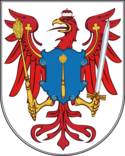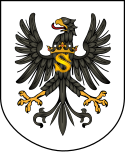Prince-elector of Brandenburg
| Brandenburg-Prussia | |||||
| Brandenburg-Preußen | |||||
| Personal union between the Margraviate of Brandenburg and Duchy of Prussia | |||||
|
|||||
|
Brandenburg-Prussia within the Holy Roman Empire (1618)
|
|||||
| Capital | Berlin and Königsberg | ||||
| Government | Feudal monarchies in personal union | ||||
| Elector-Duke | |||||
| • | 1618–1619 | John Sigismund | |||
| • | 1619–1640 | George William | |||
| • | 1640–1688 | Frederick William | |||
| • | 1688–1701 | Frederick III (Frederick I) | |||
| Historical era | Holy Roman Empire of the German Nation | ||||
| • | Personal union | August 27, 1618 | |||
| • | Prussian independence | September 19, 1657 | |||
| • | Elevation to kingdom | January 18, 1701 | |||
| Today part of |
|
||||
|
History of Brandenburg and Prussia |
|||
|
Northern March pre–12th century |
Old Prussians pre–13th century |
||
|
Margraviate of Brandenburg 1157–1618 (1806) |
Teutonic Order 1224–1525 |
||
|
Duchy of Prussia 1525–1618 |
Royal (Polish) Prussia 1466–1772 |
||
|
Brandenburg-Prussia 1618–1701 |
|||
|
Kingdom in Prussia 1701–1772 |
|||
|
Kingdom of Prussia 1772–1918 |
|||
|
Free State of Prussia 1918–1947 |
Klaipėda Region (Lithuania) 1920–1939 / 1945–present |
||
|
Brandenburg (Germany) 1947–1952 / 1990–present |
Recovered Territories (Poland) 1918/1945–present |
Kaliningrad Oblast (Russia) 1945–present |
|
Brandenburg-Prussia (German: Brandenburg-Preußen) is the historiographic denomination for the Early Modern realm of the Brandenburgian Hohenzollerns between 1618 and 1701. Based in the Electorate of Brandenburg, the main branch of the Hohenzollern intermarried with the branch ruling the Duchy of Prussia, and secured succession upon the latter's extinction in the male line in 1618. Another consequence of the intermarriage was the incorporation of the lower Rhenish principalities of Cleves, Mark and Ravensberg after the Treaty of Xanten in 1614.
The Thirty Years' War (1618–48) was especially devastating. The Elector changed sides three times, and as a result Protestant and Catholic armies swept the land back and forth, killing, burning, seizing men and taking the food supplies. Upwards of half the population was killed or dislocated. Berlin and the other major cities were in ruins, and recovery took decades. By the Peace of Westphalia, which ended the Thirty Years' War in 1648, Brandenburg gained Minden and Halberstadt, also the succession in Farther Pomerania (incorporated in 1653) and the Duchy of Magdeburg (incorporated in 1680). With the Treaty of Bromberg (1657), concluded during the Second Northern War, the electors were freed of Polish vassalage for the Duchy of Prussia and gained Lauenburg–Bütow and Draheim. The Treaty of Saint-Germain-en-Laye (1679) expanded Brandenburgian Pomerania to the lower Oder.
...
Wikipedia





